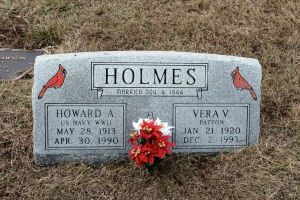By Bob Chrisman
Allen Cemetery on the outskirts of Gower, Missouri serves as the final resting place for my mother’s parents and some of her aunts, uncles, and cousins. Names like Patton, Divelbiss, Pogue, and Williams mark the plots of family members. Every Memorial Day we decorated those graves. As time passed and more relatives took up residence among the tombstones, we didn’t attend to as many of the graves. After my father’s stroke in 1969, which left him bedridden, and my sister’s departure to teach a distance away, we decorated fewer graves because my mother didn’t like to leave my father alone for long.
After my father died in 1984, Aunt Vera, my mother’s younger sister, and her husband, Uncle Howard, joined us for the annual, grave-decorating trip. Neither one of them drove anymore so they gladly came along for the outing and the lunch that followed. I would swing by their house, just up the street a few blocks from where my mother lived, and pick them up.
Uncle Howard had a great sense of humor despite the hardships of his life. He managed to find something funny about most everything. Going to the cemetery provided him with an opportunity and a captive audience. Much to my mother and aunt’s chagrin, my uncle always told me the same story on the way there.
“Bob, did I ever tell you about buying those cemetery plots?”
Although I had heard the story many times in the past, I would say, “No, Uncle Howard. What happened?” With that question he launched into the story.
“Your mom and dad and Vera and I made an appointment with Eldon Lee. You know Eldon Lee, don’t you? He was the funeral director and caretaker of the cemetery. We drove out to Gower one evening. We picked four spaces right in a row. The girls decided that we would be buried boy-girl-boy-girl.
“Eldon Lee put your father’s name down first, then your mom’s, and then he started to write my name. I said, ‘Eldon Lee, hold on. I’m not happy with this arrangement.’ They all looked at me like I’d lost a marble or two, but Eldon Lee put down his pen to hear me out.
“I said, ‘When you die, you lay down for your eternal rest to get some peace, don’t you?’ Eldon Lee nodded his head. ‘Well, how much rest and peace do you think I’d get planted between Lucile and Vera? Not much. I can tell you that right now. You better put the girls together between Len and I so all that chatter between the girls won’t disturb us in our graves.’
“That’s why your mom and Vera have places next to each other.”
He laughed in that mischievous way of his. My mother and Aunt Vera sighed. Aunt Vera said, “Oh, Howard.” No matter how many times I heard the story, I laughed. I could imagine my mother and her sister gossiping in the grave while my father snored on one side and Uncle Howard tossed and turned on the other end.
Uncle Howard had another routine that he started when we pulled up the gravel road into the cemetery. He never failed me in doing this one, which irritated my mother and aunt beyond words. That made it all the funnier because they should have known it was coming, but it always appeared to take them by surprise.
My mother and her sister decided which set of graves we would visit and in what order. My Uncle Howard pointed at new graves we passed.
“Look, Bob, see that one? Hey, you girls, would you pipe down? All your talking drives the ground squirrels away. I’m trying to see how fat they are. Looks like we’ve added lots of new dishes to the graveyard buffet lately.” He laughed.
That stopped the women’s conversation. Aunt Vera usually said, “Howard, that’s no way to talk about the dead.”
“I guess you’re right.” He paused for effect. “But, they’re dead and they don’t care about my little joke.”
Mom said, “Howard, someday you’ll be lying here in the ground and you won’t want someone talking about you like that?”
“You’re right, Lucile, but I’ll be dead and I won’t care. I’m so little and skinny the ground squirrels will be very disappointed when they lift the lid on my coffin. They’ll probably look at one another and say, ‘Ain’t much meat here. Let’s move on.’” Then he’d laugh and I’d join him.
Uncle Howard hit the buffet line in April, 1990. Aunt Vera followed in December, 1993. In February 2008, my mother joined them. My family won’t add any more people because we have scattered all over the country.
On January 1, 2009, I drove up to the cemetery to pay my respects and to remember the stories of my childhood. When I entered the cemetery I found myself looking for the new graves and the ground squirrels. I stood at the graves of my parents and my aunt and uncle. I listened as the cold wind blew through the place. I didn’t hear Mom and Aunt Vera talking. Maybe Uncle Howard’s plan worked. I hope he enjoys his eternal rest in peace.
About Bob: Bob Chrisman is a Kansas City, Missouri writer who frequently writes memoir about his family. For Memorial Day 2010, we published Desecration Day, Bob’s humorous yet moving piece about a grave decoration day that got a bit out of hand.
You can see these other pieces of Bob’s in which he writes with humor and compassion about his family members: Aunt Annie’s Scalloped Oysters and The Law Of Threes. He also published these pieces about the life and death of his mother: Hands and In Memoriam. And he produced a trilogy about his father: My Father’s Witness, Bearing Witness, and My Life With Dad.
Bob’s other red Ravine posts include Growing Older, Goat Ranch, and Stephenie Bit Me, Too.








































